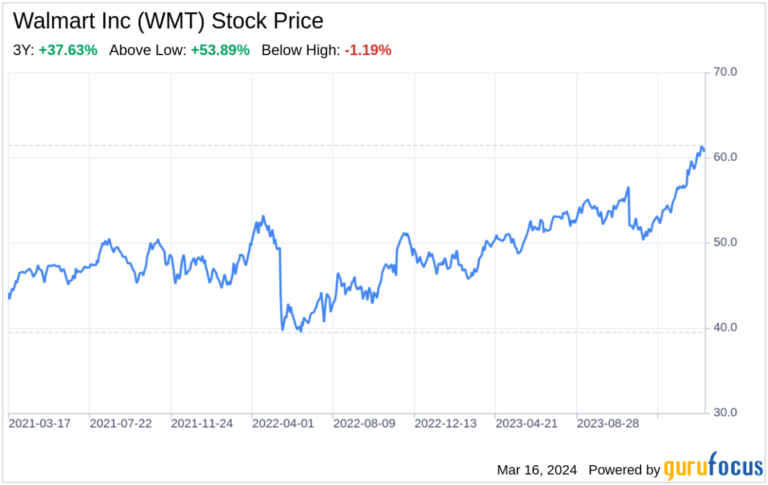-
Walmart Inc. (NYSE:WMT) is showing strong financial growth with net sales of $642.6 billion in fiscal year 2024.
-
Strategic omnichannel efforts and strong brand presence support Walmart's market dominance.
-
Competitive pressures and evolving consumer behavior are ongoing challenges for retail giants.
-
Walmart's commitment to sustainability and community engagement enhances the company's reputation.
On March 15, 2024, Walmart Inc. (NYSE:WMT), a major U.S. retailer, released its 10-K filing, disclosing comprehensive financial results for the fiscal year ended January 31, 2024. did. The company reported a significant increase. Net sales increased to $642.6 billion from $605.9 billion a year ago. This growth is a testament to Walmart's enduring appeal to consumers and its ability to remain competitive in the retail market. The company's operating income also increased significantly to $27 billion, reflecting operational efficiencies and strategic cost management. With consolidated net income of $16.3 billion, Walmart continues to demonstrate financial resilience and sustainable profitability. Taking a closer look at Walmart Inc's SWOT analysis, these financial highlights provide a solid foundation for understanding the company's strategic position and future prospects.


Strengths
Market leadership and brand equity: Wal-Mart's overwhelming market presence is the basis of the company's strength. With 2024 net sales of more than $642 billion, the company has unparalleled scale and reach in the retail industry. The Walmart brand is synonymous with value and convenience, attracting a broad customer base and fostering loyalty. The company's pricing philosophy, Everyday Low Price (EDLP) and cost reduction efforts, Everyday Low Cost (EDLC), have earned customer trust and driven consistent traffic to both physical stores and digital platforms. This has solidified our reputation as a price leader. .
Omnichannel retail strategy: Walmart has strengthened its omnichannel retail approach with strategic investments in e-commerce and technology, seamlessly integrating online and in-store experiences. Initiatives such as same-day pickup and delivery, Walmart+, and expansion of digital advertising and fulfillment services have increased customer convenience and satisfaction. The company's ability to leverage its vast store network to fulfill online orders has not only increased efficiency, but also placed Walmart at the forefront of retail innovation.
Financial health: With consolidated net income attributable to Walmart of $15.5 billion, the company's strong balance sheet underscores its financial health. Walmart's ability to generate significant cash flow allows us to invest in growth initiatives, pay dividends and conduct stock repurchases, further strengthening our market position and shareholder value.
Weakness
Dependence on US market: Despite its global presence, Walmart's financial performance is heavily dependent on the U.S. market, with domestic sales exceeding $440 billion in fiscal year 2024. This dependence on a single geographic region may expose the company to risks associated with economic downturns, regulatory changes and regulatory changes. competitive dynamics specific to the U.S. market;
Operational challenges in international markets: While Walmart's international operations contribute $115 billion in sales, they face unique challenges such as currency fluctuations, domestic competition and regulatory hurdles. The complexity of managing a diverse global portfolio can strain resources and divert focus from core markets, which can impact overall profitability.
Employee management: With approximately 2.1 million employees worldwide, Walmart must navigate complex labor relations, wage pressures, and employee retention. The company's workforce strategy aims to foster a culture of belonging and growth, but the sheer size of its employment base poses ongoing challenges in human capital management.
opportunity
Expanding digital and service offerings: Walmart has opportunities to further expand its digital footprint and service offerings, including Walmart Connect, Walmart Fulfillment Services, and Walmart GoLocal. By leveraging its ecosystem, Walmart can diversify its revenue streams, deepen customer engagement, and leverage technology to stay ahead of consumer trends and preferences.
Strategic alliances and acquisitions: The company's financial strength positions it well to pursue strategic alliances and acquisitions that can strengthen its offerings in the marketplace and drive innovation. Partnerships such as the healthcare initiative with fintech venture ONE and UnitedHealth Group could open new avenues for growth and customer acquisition.
Penetration into the global market: Walmart's international division offers significant expansion opportunities, especially in emerging markets with growing middle-class populations. By tailoring its business model to local needs and leveraging its global supply chain, Walmart can gain additional market share and diversify its geographic revenue base.
threat
Fierce competition: The retail industry is highly competitive, with companies ranging from traditional brick-and-mortar stores to e-commerce giants and omnichannel retailers. As competitors may offer more favorable terms, greater brand recognition, or more advanced digital capabilities, Walmart must continually innovate and adapt to remain competitive.
Economic and geopolitical uncertainties: Macroeconomic factors such as interest rates, energy costs, and currency fluctuations can affect consumer spending and Walmart's operating costs. Geopolitical tensions and trade barriers could also affect the company's global supply chains and market access, disrupting its business model.
Regulatory and legal risks: Walmart operates in a complex regulatory environment and faces potential legal challenges that could result in financial penalties and reputational damage. Complying with evolving regulations, especially in areas such as labor law, data privacy, and environmental standards, requires vigilance and adaptability.
In conclusion, Walmart Inc.'s (NYSE:WMT) position remains unchanged.
This article created by GuruFocus is intended to provide general insight and is not intended as financial advice. Our commentary is based on historical data and analyst forecasts using an unbiased methodology and is not intended to serve as specific investment guidance. It does not constitute a recommendation to buy or sell stocks, and does not take into account your individual investment objectives or financial situation. Our objective is to provide fundamental data-driven analysis over time. Please note that our analysis may not incorporate the latest announcements or qualitative information from price-sensitive companies. GuruFocus has no position in the stocks mentioned herein.
This article first appeared on GuruFocus.


